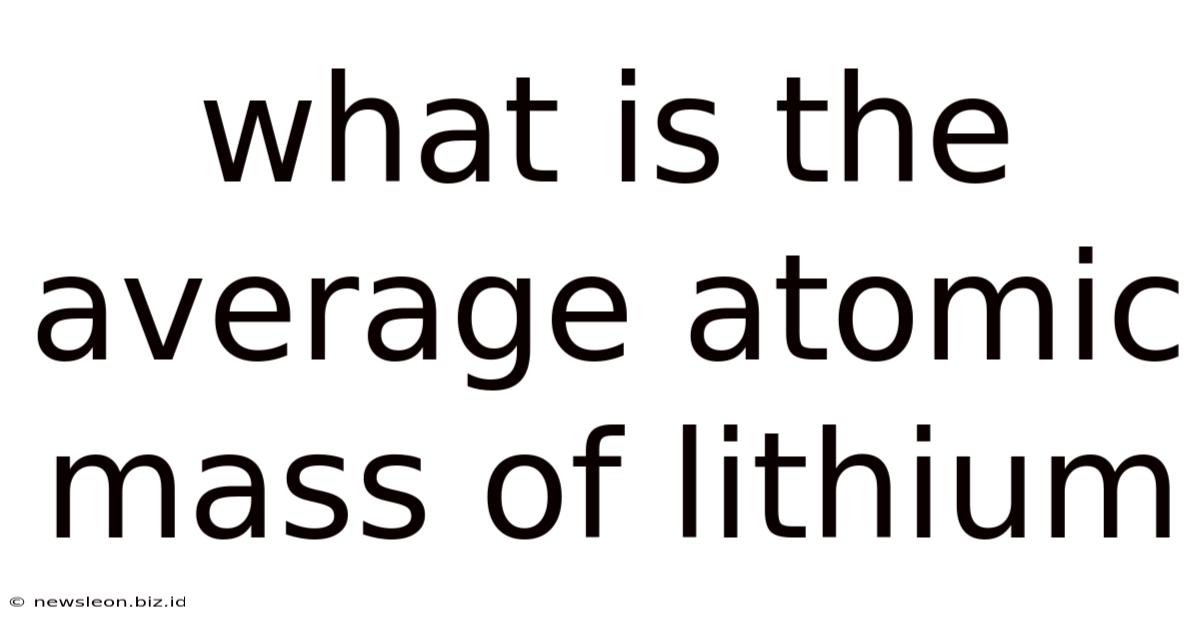What Is The Average Atomic Mass Of Lithium
News Leon
May 04, 2025 · 5 min read

Table of Contents
What is the Average Atomic Mass of Lithium? A Deep Dive into Isotopes and Atomic Weight
Lithium, a fascinating element with a vibrant history and diverse applications, holds a unique place in the periodic table. Its relatively low atomic number and intriguing properties make it a subject of ongoing scientific interest. But what exactly is the average atomic mass of lithium, and how is this value determined? This article will delve into the intricacies of atomic mass, isotopic abundance, and the calculations involved in determining the average atomic mass of lithium.
Understanding Atomic Mass and Isotopes
Before we tackle the average atomic mass of lithium specifically, let's establish a fundamental understanding of these concepts.
Atomic Mass: The Weight of an Atom
The atomic mass (or atomic weight) of an element is the average mass of all the isotopes of that element, weighted by their relative abundance in nature. It's not simply the mass of a single atom, but a weighted average reflecting the mix of isotopes typically found. It's expressed in atomic mass units (amu), where 1 amu is approximately the mass of a single proton or neutron.
Isotopes: Variations on an Element
Isotopes are atoms of the same element that have the same number of protons (defining the element) but a different number of neutrons. This difference in neutron number alters the atom's mass but not its chemical properties. For example, all atoms with three protons are lithium atoms, regardless of the number of neutrons they possess. Different isotopes of an element are often represented as ¹²C, ⁶Li, etc., where the superscript indicates the mass number (protons + neutrons).
Lithium's Isotopes: The Building Blocks of Average Atomic Mass
Lithium, denoted by the symbol Li and atomic number 3, has two naturally occurring stable isotopes:
- Lithium-6 (⁶Li): This isotope has three protons and three neutrons, giving it a mass number of 6.
- Lithium-7 (⁷Li): This isotope also has three protons but four neutrons, resulting in a mass number of 7.
While other isotopes of lithium exist, they are radioactive and have extremely short half-lives, meaning they are not significantly present in naturally occurring lithium. Therefore, the calculation of lithium's average atomic mass focuses primarily on the abundance of ⁶Li and ⁷Li.
Calculating the Average Atomic Mass of Lithium
The average atomic mass of lithium is a weighted average, considering the relative abundance of each isotope. To calculate this:
-
Determine the isotopic abundances: Precise measurements using mass spectrometry reveal the relative abundance of each isotope. The abundance of ⁶Li is approximately 7.6%, and the abundance of ⁷Li is approximately 92.4%. These percentages are crucial for calculating the weighted average.
-
Multiply the mass of each isotope by its abundance: The mass of ⁶Li is approximately 6 amu, and the mass of ⁷Li is approximately 7 amu. We multiply these masses by their respective abundances (expressed as decimals):
- ⁶Li: 6 amu * 0.076 = 0.456 amu
- ⁷Li: 7 amu * 0.924 = 6.468 amu
-
Sum the weighted masses: Finally, we add the weighted masses of both isotopes to find the average atomic mass:
- 0.456 amu + 6.468 amu = 6.924 amu
Therefore, the average atomic mass of lithium is approximately 6.924 amu. This value is what's typically found on the periodic table.
The Significance of Average Atomic Mass
The average atomic mass of lithium, and other elements, holds significant importance in various scientific and technological fields:
-
Stoichiometric Calculations: In chemistry, accurate calculations involving the mass of reactants and products in chemical reactions depend on the average atomic mass. This is crucial for accurate predictions and experimental design.
-
Nuclear Physics and Astrophysics: Understanding isotopic abundances and average atomic masses is vital in nuclear physics research, particularly in studies involving nuclear reactions and the formation of elements in stars. Isotopic ratios can provide valuable insights into stellar nucleosynthesis processes.
-
Material Science and Engineering: The properties of lithium-based materials, from batteries to alloys, are heavily influenced by the isotopic composition. The average atomic mass is an essential parameter in material characterization and design.
-
Geochemistry and Cosmochemistry: Isotopic ratios of lithium in geological samples and meteorites can provide clues about the age and origin of these materials. The average atomic mass serves as a reference point for these investigations.
Factors Affecting Isotopic Abundance and Average Atomic Mass
While the average atomic mass of lithium is relatively constant, minor variations can exist due to several factors:
-
Sample Origin: Isotopic abundances can differ slightly depending on the source of the lithium sample. This can be due to geological processes or variations in the original formation of the element.
-
Purification Methods: Purification processes can potentially alter the isotopic ratios to a small degree.
-
Nuclear Reactions: Certain nuclear reactions can alter isotopic abundance. However, the effect on naturally occurring lithium is negligible.
Conclusion: A Precise Value with Wide-Ranging Implications
The average atomic mass of lithium, approximately 6.924 amu, is not simply a numerical value but a fundamental property reflecting the weighted average of its naturally occurring isotopes. This value is critical for various scientific disciplines, influencing calculations, research, and technological advancements. The precision and accuracy of this value underscore the importance of meticulous isotopic analysis and its applications in numerous fields, ranging from everyday chemical reactions to investigations of the cosmos. The continued study of lithium's isotopic composition will undoubtedly lead to further breakthroughs and a deeper understanding of this remarkable element.
Latest Posts
Related Post
Thank you for visiting our website which covers about What Is The Average Atomic Mass Of Lithium . We hope the information provided has been useful to you. Feel free to contact us if you have any questions or need further assistance. See you next time and don't miss to bookmark.